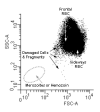Methodology and application of flow cytometry for investigation of human malaria parasites
- PMID: 21296083
- PMCID: PMC3071436
- DOI: 10.1016/j.jim.2011.01.015
Methodology and application of flow cytometry for investigation of human malaria parasites
Abstract
Historically, examinations of the inhibition of malaria parasite growth/invasion, whether using drugs or antibodies, have relied on the use of microscopy or radioactive hypoxanthine uptake. These are considered gold standards for measuring the effectiveness of antimalarial treatments, however, these methods have well known shortcomings. With the advent of flow cytometry coupled with the use of fluorescent DNA stains allowed for increased speed, reproducibility, and qualitative estimates of the effectiveness of antibodies and drugs to limit malaria parasite growth which addresses the challenges of traditional techniques. Because materials and machines available to research facilities are so varied, different methods have been developed to investigate malaria parasites by flow cytometry. This review is intended to serve as a reference guide for advanced users and importantly, as a primer for new users, to support expanded use and improvements to malaria flow cytometry, particularly in endemic countries.
Copyright © 2011 Elsevier B.V. All rights reserved.
Figures




Similar articles
-
Flow cytometry in malaria detection.Methods Cell Biol. 1994;42 Pt B:295-318. doi: 10.1016/s0091-679x(08)61081-x. Methods Cell Biol. 1994. PMID: 7533245 No abstract available.
-
A rapid and robust tri-color flow cytometry assay for monitoring malaria parasite development.Sci Rep. 2011;1:118. doi: 10.1038/srep00118. Epub 2011 Oct 14. Sci Rep. 2011. PMID: 22355635 Free PMC article.
-
Identification and classification of the malaria parasite blood developmental stages, using imaging flow cytometry.Methods. 2017 Jan 1;112:157-166. doi: 10.1016/j.ymeth.2016.06.021. Epub 2016 Jun 25. Methods. 2017. PMID: 27350362
-
Folic acid supplementation and malaria susceptibility and severity among people taking antifolate antimalarial drugs in endemic areas.Cochrane Database Syst Rev. 2022 Feb 1;2(2022):CD014217. doi: 10.1002/14651858.CD014217. Cochrane Database Syst Rev. 2022. PMID: 36321557 Free PMC article.
-
Rapid diagnostic tests for malaria parasites.Clin Microbiol Rev. 2002 Jan;15(1):66-78. doi: 10.1128/CMR.15.1.66-78.2002. Clin Microbiol Rev. 2002. PMID: 11781267 Free PMC article. Review.
Cited by
-
Performance Evaluation of Biozentech Malaria Scanner in Plasmodium knowlesi and P. falciparum as a New Diagnostic Tool.Korean J Parasitol. 2021 Apr;59(2):113-119. doi: 10.3347/kjp.2021.59.2.113. Epub 2021 Apr 22. Korean J Parasitol. 2021. PMID: 33951766 Free PMC article.
-
The XN-30 hematology analyzer for rapid sensitive detection of malaria: a diagnostic accuracy study.BMC Med. 2019 May 31;17(1):103. doi: 10.1186/s12916-019-1334-5. BMC Med. 2019. PMID: 31146732 Free PMC article. Clinical Trial.
-
Protective Effect of Chronic Schistosomiasis in Baboons Coinfected with Schistosoma mansoni and Plasmodium knowlesi.Infect Immun. 2016 Apr 22;84(5):1320-1330. doi: 10.1128/IAI.00490-15. Print 2016 May. Infect Immun. 2016. PMID: 26883586 Free PMC article.
-
Plasmodium berghei bio-burden correlates with parasite lactate dehydrogenase: application to murine Plasmodium diagnostics.Malar J. 2016 Jan 4;15:3. doi: 10.1186/s12936-015-1027-2. Malar J. 2016. PMID: 26729268 Free PMC article.
-
Flow Cytometry for Antimalarial Drug Testing: More than Meets the Eye.J Clin Microbiol. 2016 Mar;54(3):817. doi: 10.1128/JCM.03017-15. J Clin Microbiol. 2016. PMID: 26917459 Free PMC article. No abstract available.
References
-
- Ahlborg N, Iqbal J, Bjork L, Stahl S, Perlmann P, Berzins K. Plasmodium falciparum: differential parasite growth inhibition mediated by antibodies to the antigens Pf332 and Pf155/RESA. Exp Parasitol. 1996;82:155–63. - PubMed
-
- Angulo-Barturen I, Jimenez-Diaz MB, Mulet T, Rullas J, Herreros E, Ferrer S, Jimenez E, Mendoza A, Regadera J, Rosenthal PJ, Bathurst I, Pompliano DL, de las Heras F. Gomez, Gargallo-Viola D. A murine model of falciparum-malaria by in vivo selection of competent strains in non-myelodepleted mice engrafted with human erythrocytes. PLoS One. 2008;3:e2252. - PMC - PubMed
-
- Arndt-Jovin DJ, Jovin TM. Analysis and sorting of living cells according to deoxyribonucleic acid content. J Histochem Cytochem. 1977;25:585–9. - PubMed
Publication types
MeSH terms
Substances
Grants and funding
LinkOut - more resources
Full Text Sources
Other Literature Sources

